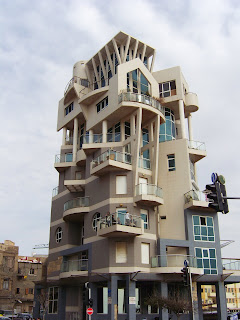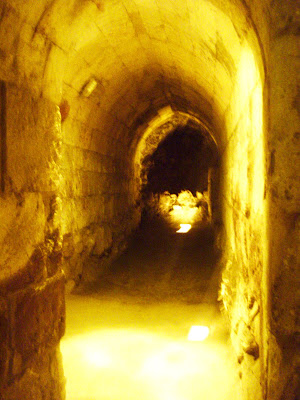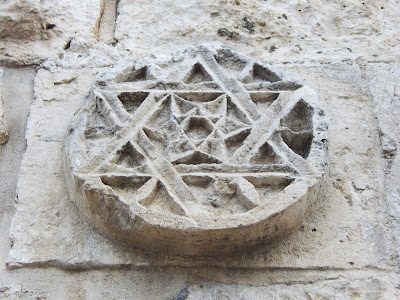Yesterday we visited the Israeli Supreme Court and the Knesset. Unfortunately neither body was in session, but we had excellent tours that highlighted the roles of these important political bodies in modern Israel. Since this is rather long, I will leave the Knesset for another post.

The Supreme Court building is relatively new, having been finished in 1992. When you walk into the building, the first thing you see is an expansive staircase leading from the ground to a panoramic window looking out to the sky and the city of Jerusalem.

The entrance was inspired by Psalms 85:11-12, "Mercy and truth are met together; righteousness and peace have kissed each other. Truth will spring up from the earth and justice will be reflected from the heavens."
The building design embodies the precepts that truth -- a factual reality, grounded and unaltered -- is transformed into justice only by looking to heaven and seeking mercy. One is physically drawn from the ground to look into the heavens while ascending the stairs.
As our guide brought us through the building, he repeatedly stressed the openness of the Courts. Every person (not merely citizen) has the legal right to petition the Supreme Court sitting as the High Court of Justice for violation of one's rights by the State. He pointed out that no identification is needed to enter the building (unlike the high security and passport requirements of the Knesset). He also pointed out that with few exceptions (such as matters involving minors or security issues), all court proceedings are open to the public.
The building has been designed to reinforce the values of the Israeli judicial system and the importance of Jerusalem. An Israeli brother and sister team won the international competition for the design. Ram and Ada Karmi incorporated Jerusalemite stone and the sweeping power of the Western Wall into the design that captured austere but inspiring arches, lines and circles. The design was inspired from Psalms: "You are righteous ... and Your laws are straight (Psalms 119:137) and "He leads me in circles of justice (Psalms 23:3).

The court system itself is an interesting example of historical precedent and political compromise. The modern court system grew out of the British court system used during its occupation as well as the religious Bet Din traditions. Juries were disfavored by the British outside of the commonwealth to avoid juries siding with the locals and nullifying British law. Instead, a system of magistrate courts for lower offenses and less valuable civil matters were established throughout the territory.
Israel adopted the system. It has thirty magistrate courts, six district courts and the Supreme Court in Jerusalem. The district court has original jurisdiction for cases involving criminal sentences that may exceed seven years or civil matters exceeding approximately $600,000. Cases below this threshold are heard by the magistrate courts. District courts also serve as intermediate appellate courts for the Magistrate Courts. From the Bet Din tradition, District Courts sit in panels of three.
The Israeli Supreme Court serves two functions. It is the highest appellate court for cases from the Magistrate and District courts and it is the High Court of Justice. As the High Court of Justice, it has original jurisdiction for cases against the State, including administrative agencies, government authorities and individuals in public office. The Supreme Court generally does not meet as a single body, but rather operates in panels - randomly assigned panels of three or more Justices. All panels have an odd number of Justices. Because the present Court has twelve members, it cannot meet in full. Our guide reported that three additional Justices will be appointed soon, raising the number to fifteen and creating the potential for the entire judiciary to meet as an
en banc panel.
The stress placed by our guide on the access to the court by every person in Israel made a strong impression. Coming out of the courtroom, Avery and Noah asked many questions about our Justices and Judges in Minnesota and the United States. They wanted to go onto the bench as they had been allowed last year when I was sworn into the Minnesota bar, but I told them that to do that we needed the permission of one of the Justices (as Justice Meyer had so graciously allowed last year.) Walking out, they asked me if I would begin collecting the autographs of the Justices I know.
The power of the visit taught them who are the real heroes in this world. Psalms captures this beautifully: "Righteousness and justice are the foundation of Thy throne; mercy and truth go before Thee." (Psalms 89:14).



 Unfortunately for us, everything closed early because it was Yom Ha'atzmaut (Israel Independence Day), so I could not go shopping at the big Dizengoff Center (somehow, Jon was not as disappointed as I was). Also, the big shuk was closed. So we walked down to the beach instead.
Unfortunately for us, everything closed early because it was Yom Ha'atzmaut (Israel Independence Day), so I could not go shopping at the big Dizengoff Center (somehow, Jon was not as disappointed as I was). Also, the big shuk was closed. So we walked down to the beach instead.

































